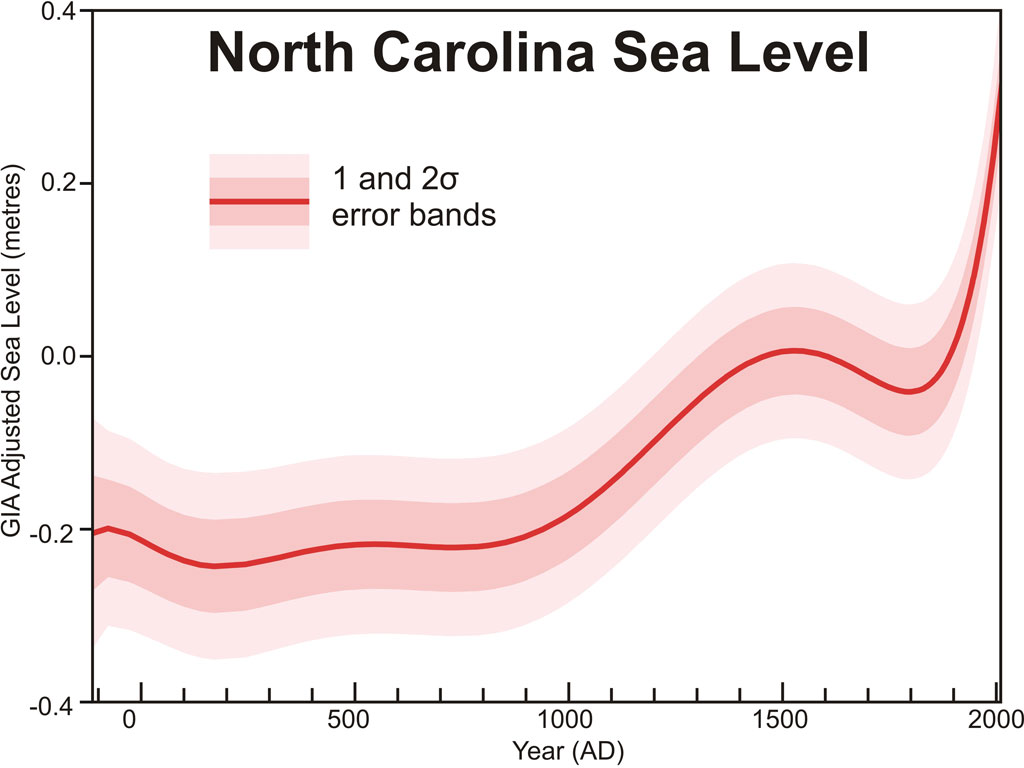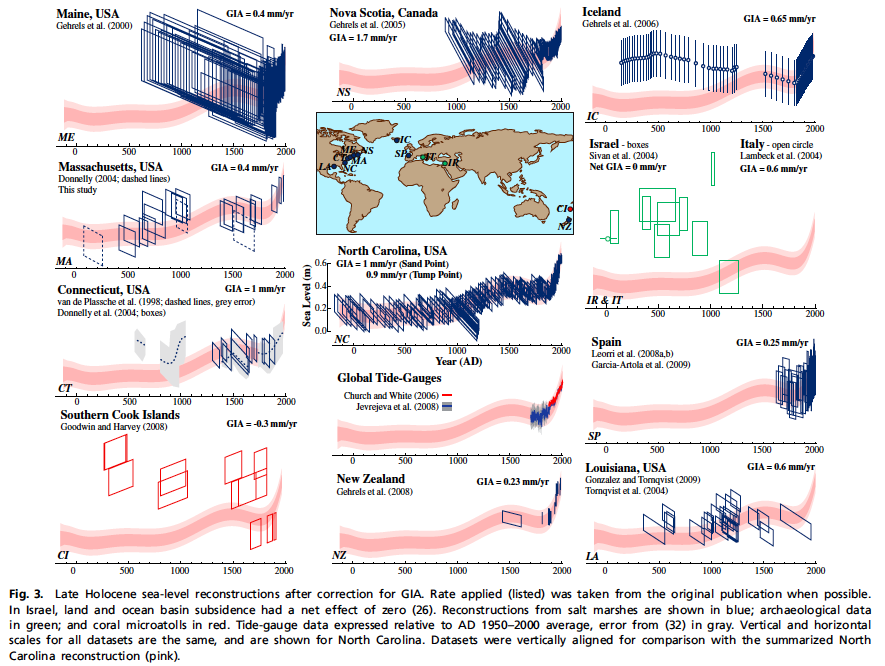Sea Level Hockey Stick
Posted on 23 June 2011 by dana1981
A paper recently published in the Proceedings of the National Academy of Sciences by Kemp et al. (2011) has assembled new sea level reconstructions for the past 2,100 years based on sediment from the US Atlantic coast. They found that recent sea level rise is the fastest over the last 2100 years:
Figure 1: Sea level reconstruction by Kemp et al. (2011) using sediment from salt marshes in North Carolina. This figure has also been added to the high resolution graphics page.
Among the co-authors of this paper are some heavy hitters in climate research: Michael Mann, Martin Vermeer, and Stefan Rahmstorf. The reconstruction is based on microfossils of foraminifera found in sediment from the US Atlantic coast." Rahmstorf explains the study methodology at RealClimate. The authors summarize their findings:
"Sea level was stable from at least BC 100 until AD 950. Sea level then increased for 400 y at a rate of 0.6 mm/y, followed by a further period of stable, or slightly falling, sea level that persisted until the late 19th century. Since then, sea level has risen at an average rate of 2.1 mm/y, representing the steepest century-scale increase of the past two millennia. This rate was initiated between AD 1865 and 1892. Using an extended semiempirical modeling approach, we show that these sea-level changes are consistent with global temperature for at least the past millennium."
In short, there was little change in their sea level reconstruction from 100 BC to 950 AD. During the Medieval Warm Period and a bit beyond, sea level rose, as one would expect. Into the Little Ice Age, sea level fell slightly, until just over a century ago, when sea level rise began to accelerate rapidly. Rahmstorf, Vermeer, and Mann used a semi-empirical model to analyze the connection of the sea level data with climate, essentially assuming that the hotter it gets, the faster sea level rises. Rahmstorf describes their conclusions:
"According to this model, the rise after about 1000 AD is due to the warm medieval temperatures and the stable sea level after 1400 AD is a consequence of the cooler “Little Ice Age” period. Then follows a steep rise associated with modern global warming. Modern tide gauge and satellite measurements indicate that sea level rise has accelerated further within the 20th Century."
"...the model fit to the new proxy data is highly consistent with the fit we obtained in 2009 to the tide gauge data. Hence it implies almost the same future projections as in our 2009 paper (75-190 cm by 2100)."
The authors note that their reconstruction is consistent with local tide gauge measurements, and also compared the North Carolina results to data gathered from nearby Massachusetts:
"The Massachusetts data agree with the North Carolina reconstruction, except for higher sea level between AD 700 and 1000 (although the uncertainty ranges overlap)."
And they compared their results to a number of other sea level reconstructions (Figure 2).
"For North Carolina, we estimate that the deviation in sea-level rise from the global mean due to ocean circulation changes is between 0 and +5 cm. This estimate was based on the IPCC AR4 model ensemble for a 21st century global warming of ∼3°C, in which sea level rises globally by 22–48 cm."
"IPCC AR4 showed that local sea-level trends differed by up to 2 mm/y from the global mean over AD 1955–2003, which implies deviations of up to ±10 cm at some locations (but ±5 cm along most coastlines) as the sum of forced and unforced effects. This analysis suggests that our data can be expected to track global mean sea level within about ±10 cm over the past two millennia, within the uncertainty band shown for our analysis."
Figure 2: Comparison of various sea level reconstructions to Kemp et al. (2011). The study's North Carolina reconstruction is shown in pink in every panel, and the other reconstructions for comparison are shown in blue, green, or red.
This sea level reconstruction is yet another member of the ever-growing hockey team (see other members here, here, and here) supporting the conclusion that the current rate of warming is greater than at any other time in the past two millenia.































 Arguments
Arguments































[dana1981] In the future, please read a post before commenting on it. The relation to global sea level is discussed in the post.
[dana1981] Please see the quote immediately above Figure 2
[DB] Insinuations of academic fraud snipped. Please re-read the Comments Policy as well. Future comments will be expected to adhere and conform to the policy. Posting here in this forum is a privilege, not a right.
[DB] Please read the OP above, paying particular attention to Figure 2.
[DB] Please, everyone, dial the emotions down a notch.
[DB] It is hard to conceive that you actually read articles in their entirety. From your linked article:
"Over the centuries, the channel silted up"
It is patently obvious the narrative you seek to maintain. If you can find peer-reviewed sources to cite that support that narrative, fine. But I would suggest reading them in their entirety to ensure that they actually say what you think they say.
[DB] See here. I well understand the tired and blind thing.
[DB] Anytime.
[DB] Let's focus on the science, not the person.
[DB] Your final linked graphic you have posted here repeatedly. And just as repeatedly, it has been pointed out the issues with conflating regional data to global data.